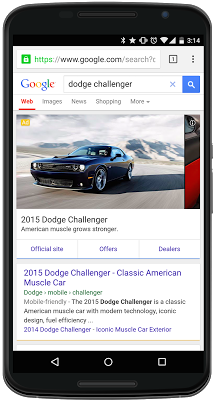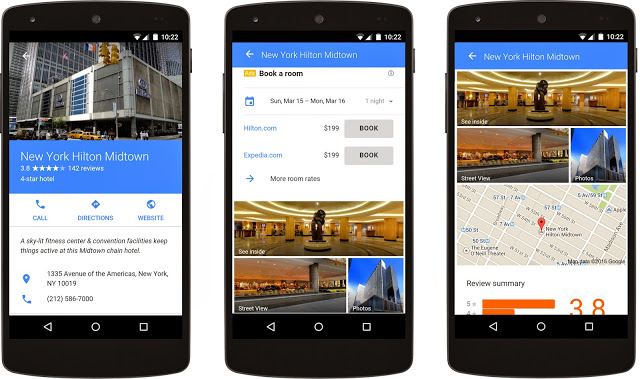On May 5th, Google Adwords had a Livestream event and it should come as no surprise to the digital marketing community that mobile was the single biggest topic on the agenda. Google announced a fresh turn for mobile dedicated ads. These new ads are chiefly aimed at comparison-shopping for cars, hotels and mortgages. Furthermore, these ads are deeply rooted in way users want to compare options as part of the shopping experience.
These new ad units are explained as being more interactive. They are going to focus on the way users navigate on phones and use swiping rather than clicking as well as strong high quality images. When a user taps an image they will be able to get additional information about the car and nearby dealerships. The hotel ads will be similar, only the user will be able to compare rates and book the hotel room from the advertisement itself. Lastly, the mortgage rate ad units will be aimed at comparing different lenders and be similar to the rollout of Google’s insurance rate comparison engine that was introduced in March.

The data justifying these changes comes from two different motivations. One is the observable popularity of mobile for search. According to Google, there are now more searches on mobile devices than computers in the US, Japan and 8 additional countries. Secondarily, when Google places itself at a lower part of the conversion funnel it means that clearly there is more money involved for Google. In the past users would need to visit each individual mortgage vendor to get a rate and now the comparative experience will happen before interaction with the lender. This is similar for the automotive shopping experience as well as the hotel comparison experience.

For the advertiser there are many advantages. The first major advantage is that tracking and attribution back to each ad unit will be even more precise. Especially when the user can book without clicking though to the hotel website. Another advantage is that it takes some of the pressure off of the advertiser for a stellar mobile experience. From an agency perspective we see clients struggle day in and day out to get conversion rates to match those of desktop or high-end mobile devices. The fact of the mater is that converting and optimizing that process puts a lot of stress on the advertiser, and as a result leads the advertiser to decrease bids on mobile that simply does not convert as well. These changes will assist advertisers and reverse these bid modifications to a certain extent.
Google also made some announcements around increased functionality in AdWords. All of the additional changes below are aimed at making the work behind campaigns easier and more intuitive for those of us building campaigns.
Dynamic Search Ads
The first major enhancement pertains to building Dynamic Search Ads. Google will now crawl your website and make recommendations for category targets and suggested CPCs. We’ll also have more visibility into which ads are showing and the landing pages they are going to. The targeting of DSAs has historically been a bit vague so this clarity will help.
Google Display Network Auto Resize
Another new feature is the ability to create ads on the Display Network that are responsive. For advertisers who have to create many different banner ad sizes for maximum visibility, the workload will decrease. Google will only ask for 3 different ad sizes and then the ads will be auto resized as needed.
Automatic Bidding Tools
When bidding in adwords there is always a balance between a volume strategy in an account and an efficiency strategy. Many advertisers use a cost-per-acquision (CPA) model to set bids. Google is now going to have a new too that simulates the outcome of bid changes base on CPAs. Now advertisers can look at the volume and cost associated with a certain CPA.
AdWords Attribution Models
In my opinion this is one of the most exciting updates that Google is making to AdWords. It elevates Adwords to a level of sophistication that we would see in a tool like Doubleclick (DS3), but this new feature will allow advertisers to use additional models other than last-click. This feature will be used in both reporting and in the automated bidding features. Google will also incorporate data-driven attribution into this feature which allows advertisers to use website conversions to find the right conversion path. This takes the guesswork out of the equation since sometimes it is challenging to pick the right attribution model and each model comes with its own pros and cons.
Cross-Device Conversions and Bidding
While this feature was covered but is not yet available, this is a way for advertisers to see the activity that is happening between mobile devices and desktops. This soon to be launched feature will be available for automated bidding as well.
Conclusion
All of the features that rolled out are extremely exciting for advertisers. The standard last-click model is simply outdated. For me personally, if I have a question or am doing quick research the first place I turn is my mobile phone. If the experience starts to become cumbersome I will turn to my tablet or computer for the final conversion, however most of my research is done on my phone in the moment I am having the conversion and thought around the purchase. Google recognizes this fact, and to a large extent so do large advertisers. Make no mistake that Google is rolling these features out in markets with the highest CPCs and the larger advertisers. It won’t be long before these capabilities are rolled out to all verticals.



